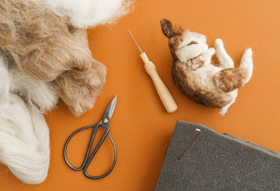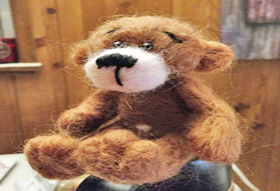
Foam for felt crafting

The arts and crafts market is growing at an exponential rate, and in 2019 its total global value was estimated to be over $51 billion. A movement that emerged in the 1860s, arts and crafts grew in popularity to prove that the introduction of modern machinery was in fact causing a decline in the quality of decorative products. Since then, arts and crafts have become an incredibly popular hobby for both adults and children alike, and felt-based craft in particular has undergone a number of significant advancements.
With a whole range of design possibilities brought by modern felt-based craft, foam is a fantastic companion material for the range of projects one may wish to undertake. Most significantly, foam is used as a protective material for needle felting, ensuring that all work surfaces and needles are protected from unnecessary damage. Commonly constructed using open-cell polyurethane, this foam is available in standard depth pads, as blocks or as thin sheets that can repeatedly withstand being punctured by a needle without severe damage to its structure. Made from high density polyurethane, these pads are robust, durable yet soft and can be reused for several projects, making them an affordable yet worthwhile investment. If not specifically listed as 'needle felt' foam, this foam is also commonly known as high-load bearing packaging foam and is known for its incredibly lightweight qualities.

Should your felt crafting project require a protective sheet or block that is generally denser and more rigid in nature, closed-cell polyethylene foam can also be used for needle felting and other felt-based craft projects. In comparison to open-cell polyurethane, closed-cell foam tends to be harder and firmer and is less springy - the perfect option should you require a more solid surface to work on. Closed-cell foam is an excellent choice should your craft project require you to pierce thicker felt components with materials that are thicker and tougher in texture, such as wool for example. In addition, closed-cell polyethylene foam is waterproof, making it an excellent working base should you wish to use paints, inks or other liquid embellishments without damaging the foam sheet or block.
Both closed and open-cell polyurethane foams can be cut to size and are the work surfaces of choice for needle felting and felt craft enthusiasts for several reasons. For example, felting often requires a completely flat surface that can both withstand pressure before springing straight back to its flat shape after being pierced by a needle. Also, foam underlays enable you to pin down your felt component to prevent it from shifting whilst you undertake intricate felting work.

Most importantly, polyurethane foam is in itself non-feltable, ensuring that your fibres will not stick to your underlay. A 'sticky' material could be problematic, for example, if you finished felting an item with green fibres before moving onto an item with white fibres. Considering the fibres are so small, the last thing you want to be doing is individually picking out the wrong coloured fibres from your work!
eFoam is the UK's leading supplier of foam and serves a number of industries and individuals in light of their foam needs. Should you require any assistance in selecting the most appropriate needle craft and felting foam for your needs, please contact us.

